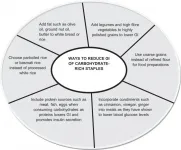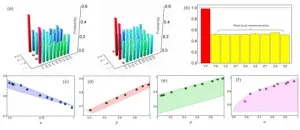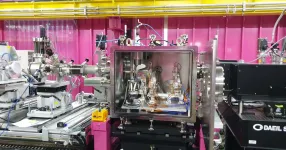How to choose low glycaemic index (GI) foods? A GI "glossary" of Asian foods released
Singapore research team's comprehensive study provides the glycaemic index values for a variety of foods that are consumed in non-Western countries, such as Singapore, Malaysia, Thailand, India, China, Japan, South Korea, Middle East and more.
2021-03-03
(Press-News.org) Professor Christiani Jeyakumar Henry, Senior Advisor of Singapore Institute of Food and Biotechnology Innovation (SIFBI), Agency for Science, Technology and Research (A*STAR) and his team have developed a Glycaemic Index (GI) glossary of non-Western foods. The research paper (attached PDF) was published in Nutrition & Diabetes on 6 Jan 2021: https://doi.org/10.1038/s41387-020-00145-w.
Observational studies have shown that the consumption of low glycaemic index (GI) foods is associated with a lower risk of type 2 diabetes mellitus (T2DM), significantly less insulin resistance and a lower prevalence of the metabolic syndrome. However, most published GI values focus on Western foods with minimal inclusion of other foods from non-Western countries, hence their application is of limited global use.
The team's comprehensive study provides the GI values for a variety of foods that are consumed in non-Western countries, such as Singapore, Malaysia, Thailand, India, China, Japan, South Korea, Middle East and more. The review extends and expands on the current GI tables to widen its application globally. The GI data compiled consists of both single and mixed meals. This is a major advance to many GI tables that have focused on single foods. Mixed meals in Asia are complex in relation to ingredients used and taste. Given the complexity, the inclusion of the GI of mixed meals is a major advantage. It is hoped that this compendium will highlight ways to reduce the GI of carbohydrate-rich staples and enhance the use of GI tables for a worldwide audience.
INFORMATION:
About the Agency for Science, Technology and Research (A*STAR)
The Agency for Science, Technology and Research (A*STAR) is Singapore's lead public sector agency that spearheads economic oriented research to advance scientific discovery and develop innovative technology. Through open innovation, we collaborate with our partners in both the public and private sectors to benefit society
As a Science and Technology Organisation, A*STAR bridges the gap between academia and industry. Our research creates economic growth and jobs for Singapore, and enhances lives by contributing to societal benefits such as improving outcomes in healthcare, urban living, and sustainability.
We play a key role in nurturing and developing a diversity of talent and leaders in our Agency and research entities, the wider research community and industry. A*STAR's R&D activities span biomedical sciences and physical sciences and engineering, with research entities primarily located in Biopolis and Fusionopolis.
For ongoing news, visit http://www.a-star.edu.sg.
[Attachments] See images for this press release:

ELSE PRESS RELEASES FROM THIS DATE:
2021-03-03
Recently, research team led by academician GUO Guangcan from CAS Key Laboratory of Quantum Information of the University of Science and Technology of China (USTC) of CAS, has made an important progress in quantum information theory. Prof. LI Chuanfeng and Prof. XIANG Guoyong from the team, cooperated with Dr. Strelstov from University of Warsaw, investigated the imaginary part of quantum theory as a resource, and several important results have been obtained. Relevant results are now jointly published as Editors' Suggestion in Physical Review Letters and Physical Review A.
Complex number is a mathematical ...
2021-03-03
It is millions of trillions of times brighter than the sunlight and a whopping 1,000 trillionth of a second, appropriately called the instantaneous light. It is the X-ray Free Electron Laser (XFEL) light that opens a new scientific paradigm. Combining it with AI, an international research team has succeeded in filming and restoring the 3D structure of nanoparticles that share structural similarities with viruses. With the fear of a new pandemic growing around the world due to COVID-19, this discovery is attracting the attention among academic circles for imaging the structure of the virus with both high accuracy and speed.
An international team of researchers from POSTECH, National University of ...
2021-03-03
Targeted, efficient and with few side effects: A new method for combating periodontitis could render the use of broad-spectrum antibiotics superfluous. It was developed and tested for the first time by a team from Martin Luther University Halle-Wittenberg (MLU), the Fraunhofer Institute for Cell Therapy and Immunology IZI and Periotrap Pharmaceuticals GmbH. The aim is to neutralise only bacteria that cause periodontitis while sparing harmless bacteria. The study appeared in the Journal of Biological Chemistry.
Periodontitis is a common bacterial inflammation of the gums. According to the World Health Organization WHO Oral ...
2021-03-03
Ask Eric Weaver about pandemics, and he's quick to remind you of a fact that illustrates the fleeting nature of human memory and the proximal nature of human attention: The first pandemic of the 21st century struck not in 2019, but 2009.
That's when the H1N1/09 swine flu emerged, eventually infecting upwards of 1.4 billion people -- nearly one of every five on the planet at the time. True to the name, swine flus jump to humans from pigs. It's a phenomenon that has been documented more than 400 times since the mid-2000s in the United States alone.
"They're considered the great mixing vessel," said Weaver, associate professor of biological sciences at the University of Nebraska-Lincoln. "They're susceptible to their own circulating ...
2021-03-03
Parents who reported more hassles using a child car seat or booster seat - such as the child is uncomfortable or having to make multiple trips in a day - were less likely to follow recommendations from the American Academy of Pediatrics (AAP) on child passenger safety, according to a study published in the journal Academic Pediatrics.
Researchers obtained information about transportation safety behaviors and 20 hassles when using child car seats among 238 socioeconomically and racially diverse parents of children 1 to 10 years of age. Eighty percent of parents reported at least a little bit of a problem with one ...
2021-03-03
Neurodegenerative disorders such as Parkinson's and Alzheimer's disease are in the firing line after researchers identified an attractive therapeutic drug target.
An international collaboration, co-led by University of Queensland researchers, has isolated and analysed the structure and function of a protein found in the brain's nerve fibres called SARM1.
Dr Jeff Nanson said the protein was activated when nerve fibres were damaged by injury, disease, or as a side effect of certain drugs.
"After a damaging incident occurs, this protein often induces ...
2021-03-03
Fireworks are used in celebrations around the world, including Independence Day in the U.S., the Lantern Festival in China and the Diwali Festival in India. However, the popular pyrotechnic displays emit large amounts of pollutants into the atmosphere, sometimes causing severe air pollution. Now, researchers reporting in ACS' Environmental Science & Technology have estimated that, although so-called environmentally friendly fireworks emit 15-65% less particulate matter than traditional fireworks, they still significantly deteriorate air quality.
Fireworks displays can cause health problems, such as respiratory ailments, because they ...
2021-03-03
Wine lovers recognize that a perfectly paired wine can make a delicious meal taste even better, but the reverse is also true: Certain foods can influence the flavors of wines. Now, researchers reporting in ACS' Journal of Agricultural and Food Chemistry have explored how lipids -- fatty molecules abundant in cheese, meats, vegetable oils and other foods -- interact with grape tannins, masking the undesirable flavors of the wine compounds.
Tannins are polyphenolic compounds responsible for the bitterness and astringency of red wines. Wine testers have noticed that certain foods reduce these sensations, improving the flavor of a wine, but scientists aren't sure why. Some studies have ...
2021-03-03
DALLAS, March 3, 2021 -- American Indian people with atrial fibrillation (AFib) had the highest risk of non-hemorrhagic stroke when compared with people in other racial and ethnic groups, and they also experienced the highest overall risk for stroke even without atrial fibrillation (AFib), according to new research published today in the Journal of the American Heart Association, an open access journal of the American Heart Association.
"In previous research, we have confirmed that American Indian individuals, when compared with those in other racial or ethnic groups, have the highest risk of atrial fibrillation, which is a quivering or irregular heartbeat that can substantially increase the risk of blood clots and stroke," said lead study ...
2021-03-03
DALLAS, March 3, 2021 -- The association between race and ethnicity and specific characteristics of some U.S. counties may have a significant impact on death rates related to cardiovascular disease, according to new research published today in the Journal of the American Heart Association, an open access journal of the American Heart Association.
Cardiovascular disease is the leading cause of death in the U.S. across all racial and ethnic groups, and disparities in cardiovascular outcomes for racial and ethnic minority groups have been documented extensively. This study presents a detailed analysis of county-level predictors of cardiovascular ...
LAST 30 PRESS RELEASES:
[Press-News.org] How to choose low glycaemic index (GI) foods? A GI "glossary" of Asian foods released
Singapore research team's comprehensive study provides the glycaemic index values for a variety of foods that are consumed in non-Western countries, such as Singapore, Malaysia, Thailand, India, China, Japan, South Korea, Middle East and more.




